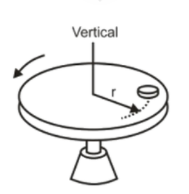A small coin is placed on a record roting at 3313 rev/minute. The coin does not slip on the record. Where does it get the required centripetal fore from?
Step by step video & image solution for A small coin is placed on a record roting at 33 1/3 rev/minute. The coin does not slip on the record. Where does it get the required centripetal fore from? by Physics experts to help you in doubts & scoring excellent marks in Class 11 exams.
Updated on:21/07/2023Topper's Solved these Questions
- CIRCULAR MOTIONBOOK - HC VERMA ENGLISHCHAPTER - CIRCULAR MOTIONEXERCISE - Exercises
30 Videos
- CENTRE OF MASS, LINEAR MOMENTUM, COLLISIONBOOK - HC VERMA ENGLISHCHAPTER - CENTRE OF MASS, LINEAR MOMENTUM, COLLISIONEXERCISE - Objective -2
11 Videos
- FLUID MECHANICSBOOK - HC VERMA ENGLISHCHAPTER - FLUID MECHANICSEXERCISE - All Questions
90 Videos
Similar Questions
A bird while flying takes a left turn,from where does it get the centripetal force ?
View SolutionA small coin is placed at a distance r from the centre of a gramophone record.The rotational speed of the record is gradually increased. If the coefficient of friction between the coin and the record is μ, the minimum angular frequency of the record for which the coin will fly off is given by :
View SolutionA coin is placed on a horizontal platform, which undergoes horizontal simple harmonic motion about a mean position O. The coin does not slip on the platform. The force of friction acting on the coin is F.
(i) F is always directed towards O
(ii) F is directed towards O when the coin is moving away from O, and away from O when the coin moves towards O
(iii) F=0 when the coin and platform come to rest momentarily at the extreme position of the harmonic motion
(iv) F is maximum when the coin and platform come to rest momentarily at the extreme position of the harmonic motion
View SolutionAs mosquito is sitting on an L.P. record disc rotating on a trun tabel at 3313 revolutions per minute. The distance of the mosquito from the centre of the turn table is 10 cm. Show that the friction coefficient between the record and the mosquito is greater than π281. Take g=10ms2
View SolutionA classroom demonstration of Newton's first law is as follows: A glass is covered with a plastic card and a coin is placed on the card. The card is given a quick strike and the coin falls in the glass. a.Should the friction coefficient between the card and the coin be small or large? b. Should the coin be light or heavy? c. Why does the experiment fail if the card is gently pushed?
View SolutionWhere from does a satellite get centripetal force for moving around its planet ?
View SolutionA wedge as shown in figure has a rough curved surface of coefficient of kinetic friction 1√3 whose shape can be given by equation y=x2, where the horizontal direction is x-axis, vertical direction as y axis and the end of surface O as origin and x & y are measured in meter. A small block is released, from a certain point on the surface. The maximum height of the point from where block should be released so that it does not slip.

View SolutionA long playing record revolves with a speed of 33(14) rev/min. and has a radius of 15 cm. Two coins are placed at 4 cm and 14 cm away from the centre of the record. If the coefficients of friction between the coin and the record is 0.15, which of the two coins will revolve with record ?
View SolutionA gramophone record is revolving with an angular velocity ω. A coin is placed at a distance R from the centre of the record. The static coefficient of friction is μ. The coin will revolve with the record if
View SolutionA small coin of mass 40 g is placed on the horizontal surface of a rotating disc. The disc starts from rest and is given a constant angular acceleration α=2 rad s−2. The coefficient of static friction between the coin and the disc is μs=3/4 and the coefficient of kinetic friction is μk=0.5. The coin is placed at a distance r=1m from the centre of the disc. The magnitude of the resultant force on the coin exerted by the disc just before it starts slipping on the disc is?

View Solution
